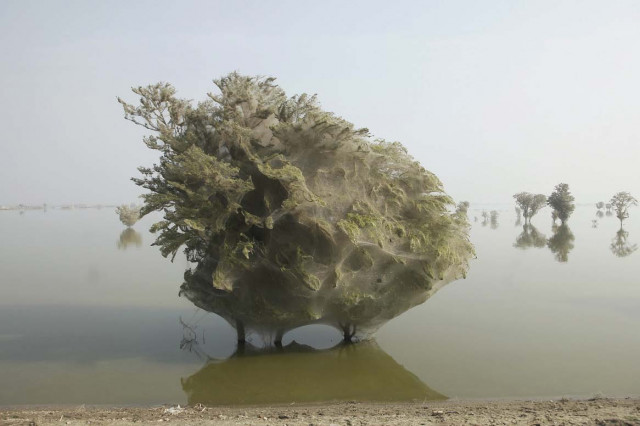Spinning tales of wonder : Enshrouded trees keep the mosquitoes away
Spiders, driven by the flood, have spun huge webs over trees in Dadu village.

The mummified trees stand along submerged paths of Khairpur Nathan Shah. With their shrouds of spiderwebs pulled over the leaves and right down to the middle of the trunks, the trees belong either to a set of a horror movie or a tomb in Egypt.
When the floods hit Sindh last year, hundreds of thousands of people moved to safer places in the province. But they weren’t the only ones seeking refuge. Although less visible, millions of spiders were also forced to leave for higher ground and the creepy crawlies found sanctuary in these trees.
The result of so many spiders living in proximity can be seen in the gigantic webs they spun and cocooned the trees in.
Russell Watkins, a multimedia editor with the UK’s Department for International Development (DFID), the organisation that manages Britain’s overseas aid programmes, photographed these ghostly trees during a trip to Pakistan in December last year. The webs are said to be more useful than they appear because of the effect on mosquitoes. Although the standing water in flood-hit areas should have been the perfect breeding ground for mosquitoes, experts have predicted the webs would help control the spread of the pests — and the diseases they bring.
Watkins said that the residents of the area where the trees were located had said they had never seen anything like this before the flood.
However, the cocooned trees have been spotted before - halfway around the world. In August 2007, Texas parks and wildlife officials found a huge spiderweb that spanned across 200 feet or more.
They said it was spun by the long-jawed orb weavers.
The web covered several trees that were 15 feet or higher. In this park’s case, the web was so thick in some places that the leaves on the trees had died because the web prevented sunlight from reaching them.
However, the park rangers maintained that the trees were “not suffering” and would not die out.
The environment of the state park in Texas was not as different from that of flood-stricken Khairpur Nathan Shah. The park had a huge pond in its centre and persistent rains in June that year had filled not just the lake but every slight hole or depression in the ground.
This sudden invasion of space might have been the factor that drove the spiders into the trees, much the same as what happened in Khairpur Nathan Shah’s case.
The park officials predicted that the webs would remain “active” till the temperatures cooled and then the spiders would eventually die.
How are the webs so huge?
To start a new web, the spider attaches her silk to one point on a branch or leaf and lets herself down several feet.
She curls into a ball at the end of the strand and waits for a breeze to blow her to the next point. If she likes where she lands, she attaches the other end of the strand and begins work on her web
Source: about.com
Published in The Express Tribune, April 8th, 2011.



















COMMENTS
Comments are moderated and generally will be posted if they are on-topic and not abusive.
For more information, please see our Comments FAQ